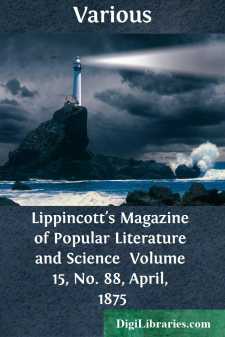Categories
- Antiques & Collectibles 13
- Architecture 36
- Art 48
- Bibles 22
- Biography & Autobiography 813
- Body, Mind & Spirit 142
- Business & Economics 28
- Children's Books 15
- Children's Fiction 12
- Computers 4
- Cooking 94
- Crafts & Hobbies 4
- Drama 346
- Education 46
- Family & Relationships 57
- Fiction 11828
- Games 19
- Gardening 17
- Health & Fitness 34
- History 1377
- House & Home 1
- Humor 147
- Juvenile Fiction 1873
- Juvenile Nonfiction 202
- Language Arts & Disciplines 88
- Law 16
- Literary Collections 686
- Literary Criticism 179
- Mathematics 13
- Medical 41
- Music 40
- Nature 179
- Non-Classifiable 1768
- Performing Arts 7
- Periodicals 1453
- Philosophy 64
- Photography 2
- Poetry 896
- Political Science 203
- Psychology 42
- Reference 154
- Religion 513
- Science 126
- Self-Help 84
- Social Science 81
- Sports & Recreation 34
- Study Aids 3
- Technology & Engineering 59
- Transportation 23
- Travel 463
- True Crime 29
Lippincott's Magazine of Popular Literature and Science Volume 15, No. 88, April, 1875
by: Various
Description:
Excerpt
CONCLUDING PAPER.
FOREST OF COCKATOOS.People who go to Australia expecting every other man they meet to be a convict, and every convict a ruffian in felon's garb, will assuredly find themselves mistaken. And if contemplating a residence in Sydney or Melbourne they need not anticipate the necessity of living in a tent or a shanty, nor yet of accepting the society of convicts or negroes as the only alternative to a life of solitude. Neither will it be necessary to go armed with revolvers by day, nor to place plate and jewels under guard at night. Sydney, the capital of the penal colony, is a quiet, orderly city, abounding in villas and gardens, churches and schools, and about its well-lighted streets ride and walk well-dressed and well-bred people, whose visages betray neither the ruffian nor the cannibal. Some of them may be convicts or "ticket-of-leave-men," but this a stranger would need to be told, as they dress like others, their equipages are quite as stylish, and many of them not only amass more property, but are really more honest, than some of those never sentenced, because they know that the continuance of their freedom depends on their reputation.
SYDNEY.
The city, built on the south side of a beautiful lake, is perfectly unique in design, being composed of five broad promontories, looking like the five fingers of a hand slightly expanded. All the important streets run from east to west, and each terminates in a distinct harbor, while clearly visible from the upper portion of the street is a grand moving panorama of vessels of every description, with masts, sails and colors that seem peering out from every interstice between the houses. Each day witnesses the arrival and departure of eight or ten steamers, ferry-boats leave every half hour all the principal landings for the various sections of the city, and the wharves are lined with the shipping of every nation, many of the vessels ranging from fifteen hundred to two thousand tons burden. On a huge rock in Watson's Bay stands the lighthouse at the entrance of Port Jackson. The sea lashes the black rock with ceaseless fury, the light from the summit rendering even the base visible at a great distance. The light is 350 feet above the level of the sea, yet it was almost under its very rays that the good ship Dunbar came to grief. Missing the passage, she was engulfed in the raging sea, and her three hundred and ninety passengers perished in full view of the homes they were seeking.
Orange and almond trees, with other tropical plants, loaded with blossoms and fruit, beautify the lowlands, while in more elevated localities are found the fruits and foliage of the temperate zone, very many of them exotics brought by the settlers from their English homes. Down to the very water's edge extends the verdure of tree and shrub, overshadowing to the right Fort Jackson, and to the left Middle Harbor. The Government House commands the bay with the imposing mien of a fortress, and the magnificent reception-rooms are worthy of a sovereign's court....












